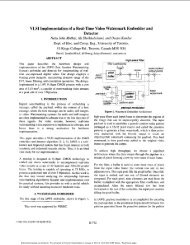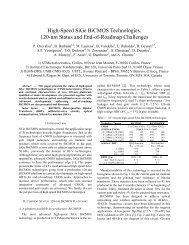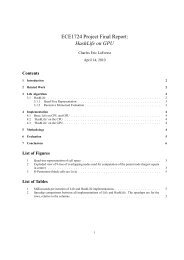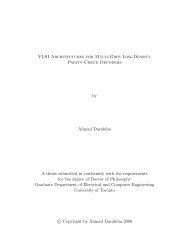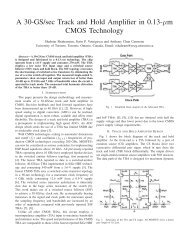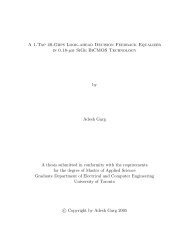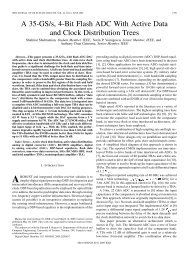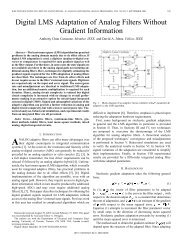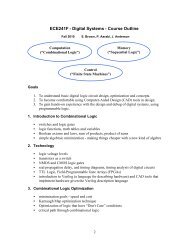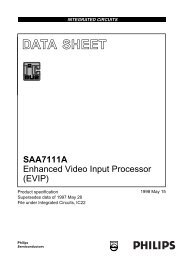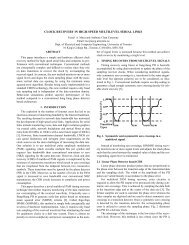ieee transactions on very large scale integration (vlsi) - Computer ...
ieee transactions on very large scale integration (vlsi) - Computer ...
ieee transactions on very large scale integration (vlsi) - Computer ...
Create successful ePaper yourself
Turn your PDF publications into a flip-book with our unique Google optimized e-Paper software.
YANG et al.: EXTRACTION ERROR MODELING AND AUTOMATED MODEL DEBUGGING IN HIGH-PERFORMANCE CUSTOM DESIGNS 765<br />
used to generate local clocks with required frequencies, and<br />
manual extracti<strong>on</strong> of such complex comp<strong>on</strong>ents is a process<br />
which is particularly pr<strong>on</strong>e to errors.<br />
B. Problem Characteristics<br />
Extracti<strong>on</strong> errors occur frequently in test model generati<strong>on</strong><br />
of high-performance designs in c<strong>on</strong>temporary nanometer<br />
nm technologies where many libraries that c<strong>on</strong>tain<br />
various instantiati<strong>on</strong>s of an element with different characteristics<br />
are utilized. Real-life informati<strong>on</strong> about the frequency<br />
of extracti<strong>on</strong> errors in a typical industrial design cycle shows<br />
that, for e<strong>very</strong> library that c<strong>on</strong>tains a few hundred modules, the<br />
extracti<strong>on</strong> process is <strong>very</strong> likely to introduce an error in the<br />
test model for the 180-, 90-, and 65-nm technologies. Once the<br />
model is verified to be err<strong>on</strong>eous, the impact of these errors in<br />
the design cycle varies from a few labor days to more than <strong>on</strong>e<br />
labor week of manual debugging by the test engineer. Clearly,<br />
this is a resource-intensive process that increases the costs, and<br />
it may jeopardize prompt test deli<strong>very</strong> to the factories.<br />
There are several sources of extracti<strong>on</strong> errors during test<br />
model generati<strong>on</strong> [21], [22]. Logic extracti<strong>on</strong> may introduce<br />
errors in the final flattened netlist due to err<strong>on</strong>eous module mappings<br />
by the designer or because of bugs in the automated CAD<br />
tools. Additi<strong>on</strong>al sources of errors are functi<strong>on</strong>al mismatches in<br />
the definiti<strong>on</strong> of module operati<strong>on</strong> c<strong>on</strong>straints between different<br />
libraries [e.g., simulati<strong>on</strong> library, synthesis library, physical<br />
design library, and automatic test pattern generati<strong>on</strong> (ATPG)<br />
library]. In this case, the mapping is correct, but corner-case<br />
specificati<strong>on</strong>s about the operati<strong>on</strong> of the module(s) are interpreted<br />
differently by various libraries. In both cases, these<br />
errors may change the functi<strong>on</strong>ality of the extracted test model.<br />
Notice that, due to the nature of the extracti<strong>on</strong> process, a<br />
single error c<strong>on</strong>tained in a module definiti<strong>on</strong> may produce multiple<br />
err<strong>on</strong>eous instantiati<strong>on</strong>s in the final netlist. Modern design<br />
methodologies are traditi<strong>on</strong>ally based <strong>on</strong> a hierarchical compositi<strong>on</strong><br />
to simplify the design efforts [15]. E<strong>very</strong> circuit is a collecti<strong>on</strong><br />
of blocks, and each block c<strong>on</strong>tains a varying number of<br />
more basic comp<strong>on</strong>ents which are replicated instances of simpler<br />
modules. In this manner, a single module is usually instantiated<br />
into many copies in the final netlist.<br />
This hierarchical informati<strong>on</strong> is useful during extracti<strong>on</strong>.<br />
Instead of working <strong>on</strong> individual instances of a module piece by<br />
piece, the process extracts the gate-level model of a module and<br />
then it applies the extracted model to all instances of that module<br />
according to an instantiati<strong>on</strong> module mapping informati<strong>on</strong> using<br />
pattern matching, ruled-based or symbolic approaches [4]–[6],<br />
[10], [13]. This also implies that an error during the extracti<strong>on</strong> <strong>on</strong><br />
a single module may result into multiple errors in the final flattened<br />
netlist. This situati<strong>on</strong> is depicted in Fig. 3, where a single<br />
error in the mapping for Module 1 “translates” to two errors in<br />
the final netlist. Due to the presence of multiple error effects,<br />
diagnosis may become a challenging task because the soluti<strong>on</strong><br />
space grows exp<strong>on</strong>entially [18]. However, the instantiati<strong>on</strong><br />
module mapping informati<strong>on</strong> is usually known to the engineer.<br />
In other words, recognizing <strong>on</strong>e line that is a source of error is<br />
sufficient to identify the remaining lines and rectify the design<br />
by replacing all err<strong>on</strong>eous modules in the netlist.<br />
Fig. 3. Multiple error instantiati<strong>on</strong>.<br />
An additi<strong>on</strong>al challenge when debugging extracti<strong>on</strong> errors is<br />
the fact that state equivalence informati<strong>on</strong> between the transistor<br />
level and the test model may not be fully available to the<br />
engineer. Extracti<strong>on</strong> tools often locally c<strong>on</strong>vert the transistor<br />
comp<strong>on</strong>ents into logic comp<strong>on</strong>ents without recording informati<strong>on</strong><br />
about this mapping process. Hence, when designers<br />
receive the extracted netlist, they may not have a <strong>on</strong>e-to-<strong>on</strong>e<br />
structural corresp<strong>on</strong>dence between registers of the test model<br />
and the transistor-level schematic. Full state equivalence between<br />
the schematic and the test model is usually observed<br />
in blocks designed with standard logic synthesis tools. Partial<br />
state equivalence (i.e., equivalence <strong>on</strong>ly at design block interfaces)<br />
and/or no state equivalence is a comm<strong>on</strong> characteristic<br />
of custom/manual designed register files and datapaths. On<br />
the average, our experience indicates that 40%–60% of the<br />
equivalence informati<strong>on</strong> remains available.<br />
Due to the lack of this informati<strong>on</strong>, the complexity of the<br />
diagnosis is increased both in space and in time [19]. For example,<br />
registers cannot serve as pseudoinputs/outputs, and <strong>on</strong>ly<br />
resp<strong>on</strong>ses at primary outputs can be used to verify the correctness<br />
of the implementati<strong>on</strong>. Furthermore, without access to the<br />
registers, it may take several clock cycles to activate the error<br />
and propagate the effects to the outputs. C<strong>on</strong>sequently, diagnosis<br />
involves analysis <strong>on</strong> the states of the circuit in several different<br />
time frames that adds to the complexity of debugging.<br />
III. EXTRACTION ERROR TYPES<br />
Here, we study sets of extracti<strong>on</strong> error types that are comm<strong>on</strong><br />
in high-performance cores, for example, for microprocessors,<br />
SoCs, and ASICs, in the industry today [2], [3], [7], [8], [11],<br />
[12], [17]. With respect to the terminology and circuit architecture<br />
from Secti<strong>on</strong> II, we divide these error types into two categories,<br />
core error types and clocking circuitry error types, and<br />
we present them accordingly.<br />
A. Core Error Types<br />
1) Reset Synchr<strong>on</strong>icity Error: A <strong>large</strong> porti<strong>on</strong> of the silic<strong>on</strong><br />
area in c<strong>on</strong>temporary designs is dedicated to storage [15].<br />
Memory elements such as flip-flops comm<strong>on</strong>ly have either a<br />
synchr<strong>on</strong>ous or an asynchr<strong>on</strong>ous reset, shown in Fig. 4. As<br />
illustrated in Fig. 4(b), a D-flip-flop with asynchr<strong>on</strong>ous<br />
reset is evaluated as so<strong>on</strong> as an event arrives at its reset port,<br />
whereas a flip-flop with synchr<strong>on</strong>ous reset cannot change its<br />
value until a clock-edge occurs. During test model extracti<strong>on</strong>,<br />
a library element that c<strong>on</strong>tains a flip-flop with an asynchr<strong>on</strong>ous



